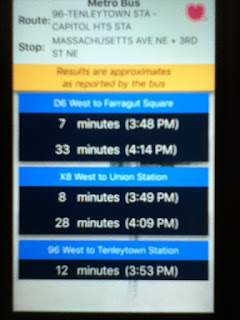| "Bypasses have got to be built." And interstate highways have got to be widened. |
Despite a public meeting this week, we're still without specifics on the cost, or on the metrics that justify the expansion. We need to know: How much time are we buying with our X hundred million dollars, and whose time are we saving? Consider that this is a 12-mile stretch of highway, with a 70-mile-an-hour speed limit (though the design speed surely is higher). Driving either direction between Iowa City and Cedar Rapids, and assuming no obstructions, you should make it through this patch in about 10 minutes. In heavy traffic, that time will increase, but at what point do we say it's congestion? And how long does that "congestion" last--one hour a day?
Google Maps has a traffic function that allows the user to see where traffic is heavy, and how that affects travel times. So far, checking during morning and evening rush hours, I have yet to see heavy traffic on I-380, and travel times are always normal. You want to see congestion, check out I-290 west of Chicago.
So, when governments everywhere are financially stressed, infrastructure has been described as "crumbling" for a quarter-century, Iowa is closing schools and mental health centers and using contingency funds to balance the budget, is the I-380 "problem" that some politically-vocal drivers are annoyed when other drivers are doing 65 in a 70 zone--or 70 when they want to go 85--and they can't pass them? Politically-connected construction companies that need contracts? Politicians themselves who miss cutting ribbons? I hate to be sounding so cynical, but I'm just not getting any better explanation.
What will happen when, after months of construction-related detours and delays, the highway is widened? Here are two scenarios.
Low induced demand (traffic stays around 54000 cars/day). Induced demand is not an intuitive concept. After all, as the ARTBA says on their websites, laying sewer pipe doesn't cause people to go to the bathroom more often! It is pretty exhaustively documented (see the earlier post), but usually in places like Los Angeles or Houston or London. Eastern Iowa is not highly-populated, and is not likely to be. So it could be the induced demand effect will be barely noticeable. Travel times will change marginally at most, and the driving experience won't be as much better as some people seem to think it will be. It will be, in short, a substantial expenditure of government money for nothing much in return. What we should have done instead: Nothing. Maybe fund schools and mental health.
High induced demand (traffic continues to increase, say to 72000-81000 cars/day). The appearance or expectation of a smoother ride might drive more people to live farther from work i.e. Ely, Fairfax, North Liberty, Shueyville, Solon, Swisher, or rural Linn or Johnson counties. This will help to fill up that third lane, so that in a few years traffic will be just as "bad" as it is now. On the other hand, it will also boost population and the tax rolls in those little towns and rural areas. They may well have a stake in facilitating commuters, and would expect to reap substantial benefits while bearing little of the costs. Here in D.C. there've been proposals floated to build a bullet train to Baltimore. There are a lot of unanswered questions about this, but the areas in between are wondering why they should provide land for a train that will favor these two major cities while bypassing them. What we should have done instead: Regional revenue sharing, (see also Liu and Arnosti 2018) and at least investigate passenger rail.
Whatever decision is made, and however it comes out, we should take collective actions for the right reasons. The Hamilton Project's recent study of infrastructure policy lists a number of standards for evaluating projects (2017: 2): economic return on investment (see also Marohn 2013 and 2016), economic vs. political considerations, rate of depreciation, cost of borrowing, where the money is coming from, and need for economic stimulus. By any of these standards, does widening I-380 pass the smell test?
OTHER READING:
Tod Litman, "Urban Sprawl Costs the American Economy More Than $1 Trillion Annually," LSE US Centre, 1 June 2015Diane Whitmore Schanzenbach, Ryan Nunn and Greg Nantz, "If You Build It: A Guide to the Economics of Infrastructure Investment," The Hamilton Project, February 2017
[P.S.: See also Dirk Vander Hart, "A New Report Shows Highway Widening Won't Solve Portland's Congestion Woes," Portland Mercury, 7 March 2018]








.svg/600px-I-380_(IA_1957).svg.png)
_map.svg/1200px-I-380_(IA)_map.svg.png)

















